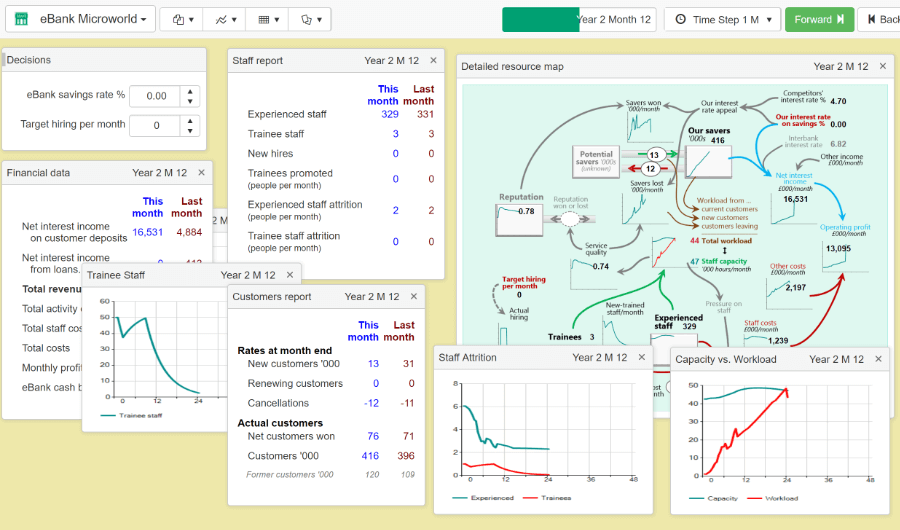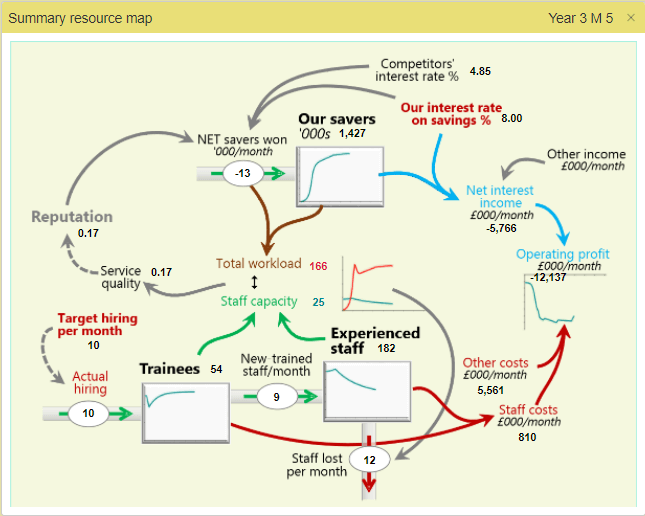eBank Microworld
Starting a new savings bank
This is a small-scale game, reflecting the start-up of a low-cost, direct-service savings bank, similar to the 1998 launch of the UK firm 'Egg', as well as similar business models in other countries. Specifically, the challenge is to turn the business into a sustainable, strong profit generator within 36-48 months.
eBank presents the difficult challenge of matching staffing levels with rapidly varying workloads, when there are unavoidable delays in getting the staff required. Low costs and high interest rates make it attractive for savers to invest their money with this business. But get that staffing wrong, and not only will poor service damage the company's growth prospects, but existing staff may leave as well.
It has close analogies with any service-based business that relies on trained staff, such as: on-line insurance companies, road-side repair operations, and public services. Similar issues arise for organisations selling physical goods that require after-sales support.

Features
General points
Launching a new savings bank in the market presents the challenge of matching staffing levels with rapidly varying workloads.
The simulation runs over 48 months, with monthly decisions. Decisions can be set to repeat over a number of periods automatically.
Objectives
Grow a sustainable and profitable savings bank.
| Feature List | |
|---|---|
| DECISIONS | Two decisions: Interest rate offered to savers and the number of people to hire for the call centre Teams choose when to run forward and the simulation runs forward one month with each step, or teams can choose to repeat decisions over several months. A 'Go back' option allows previous decisions to be revised an alternative strategies explored. |
| CHALLENGES | Four challenges included - part played scenarios that provide different situations for students to work with. |
| SAVE CHALLENGES | Teams can save the game at any point, to explore alternative strategies. |
| RESOURCE MAP | A 'Resource Map' of the business architecture showing key resource relationships is available in simple and expanded form. |
| REPORTS | Numerical reports showing relevant financial and operational data. |
| GRAPHS | Preset graphs showing the history of key data items. Additionally, Any item appearing in a table can be represented as a graph - simply double click on the table heading. |
| TABLE DATA | Tables show history of financial and service data, as well as a single table of all public data and one of user decsions. Tables can be exported in CSV format to enable analysis. |
| SAVE COMMENTS WITH GAMES | Can add comments to games either for display in games list or in a "Game Notepad". |
| COPY TO OTHER APPLICATIONS | Use screen capture to obtain images of Reports or Graphs for copying into other applications for inclusion in documents and slide presentations produced. |
| TEACHERS MATERIALS | Event managers materials include the user’s guide as well as instructor’s slides and slide notes. |
Uses
This game can be played by individuals or small teams. It plays out business performance over a time-scale that is long enough to experience the complexity of strategy and decision-making. Teams control strategy by making a small number of key decisions, and can progress through the simulation at their own pace, trying alternatives and saving scenarios.
Event materials include the user's guide for students and, for instructor's, slides and slide notes.
The courses in which it may be useful are:
Strategy Dynamics - the business resource-system, interdependence between firm resources, managing functions in harmony (sales and advertising).
Strategy courses or workshops - basics of resource-based view (RBV): connection between resources and performance.
Systems thinking courses or workshops - resource-building and feedback (reinforcing)
Marketing courses or workshops - basics of developing both customers (through advertising) and channels (through sales force), working with limited marketing budgets.
Key learning points
Generic learning points …
Business performance over time (sales and earnings) depends on the resources we have.
Resources are won and lost over time (customers = sum of all customers ever won, minus all ever lost).
Specific to this microworld …
Need for balance between growth of 'demand-side' resources (savers) and 'supply-side' resources (the service staff who provide the capacity to deal with the workload from savers).
Lead-time required to bringing resources into balance (the hiring and training time). Intangible resources (reputation) can severely constrain growth of tangible resources (savers) – it responds quickly to poor service, and slowly to improvements.
Service demand is driven by three distinct forces – the winning of new customers (new savers have to be processed), the ongoing support for having the customer-base resource (regular account statements and enquiries) and the losing of customers (processing accounts for savers who leave).

Reviews

Based on the case of an early UK internet savings bank, the focus is on keeping supply and demand in balance to create a sustainable, strong profit generator.
Can you keep the supply and demand of your savings bank services in balance to create a sustainable, strong profit generator?
You can try to build a totally new brand or take on a business that a previous team has been managing.
Play a demo
Teachers can request access to full game and inspection documentation for evaluation